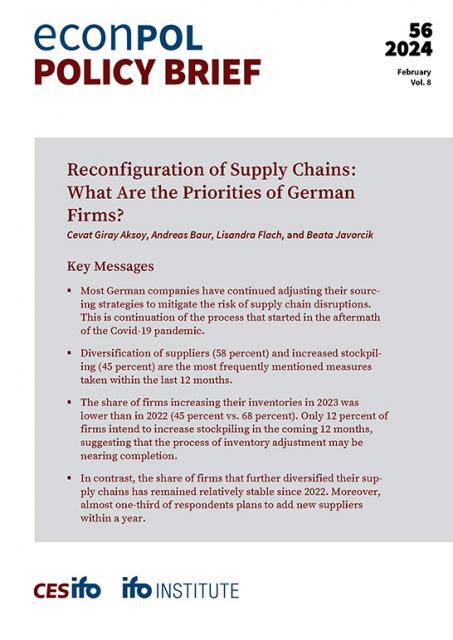Reconfiguration of Supply Chains: What Are the Priorities of German Firms?
Key Messages
- Most German companies have continued adjusting their sourcing strategies to mitigate the risk of supply chain disruptions. This is continuation of the process that started in the aftermath of the Covid-19 pandemic.
- Diversification of suppliers (58 percent) and increased stockpiling (45 percent) are the most frequently mentioned measures taken within the last 12 months.
- The share of firms increasing their inventories in 2023 was lower than in 2022 (45 percent vs. 68 percent). Only 12 percent of firms intend to increase stockpiling in the coming 12 months, suggesting that the process of inventory adjustment may be nearing completion.
- In contrast, the share of firms that further diversified their supply chains has remained relatively stable since 2022. Moreover, almost one-third of respondents plans to add new suppliers within a year.
At the height of the Covid-19 pandemic, global supply chains of firms came under increased public scrutiny. Pandemic-related production and transportation disruptions had put supply chains under severe pressure worldwide and were often associated with considerable economic costs. However, as the pandemic has subsided, the extent of supply chain disruptions has also decreased significantly. While eight out of ten German manufacturing firms reported material shortages at the height of the pandemic in December 2021, this share had fallen to 18 percent in October 2023. Nonetheless, the recent attacks by the Yemeni Houthi rebels on container ships in the Red Sea highlight the fact that supply chain risks remain significant.
Cevat Giray Aksoy, Andreas Baur, Lisandra Flach, and Beata Javorcik: “Reconfiguration of Supply Chains: What Are the Priorities of German Firms?,” EconPol Policy Brief 56, February 2024.
